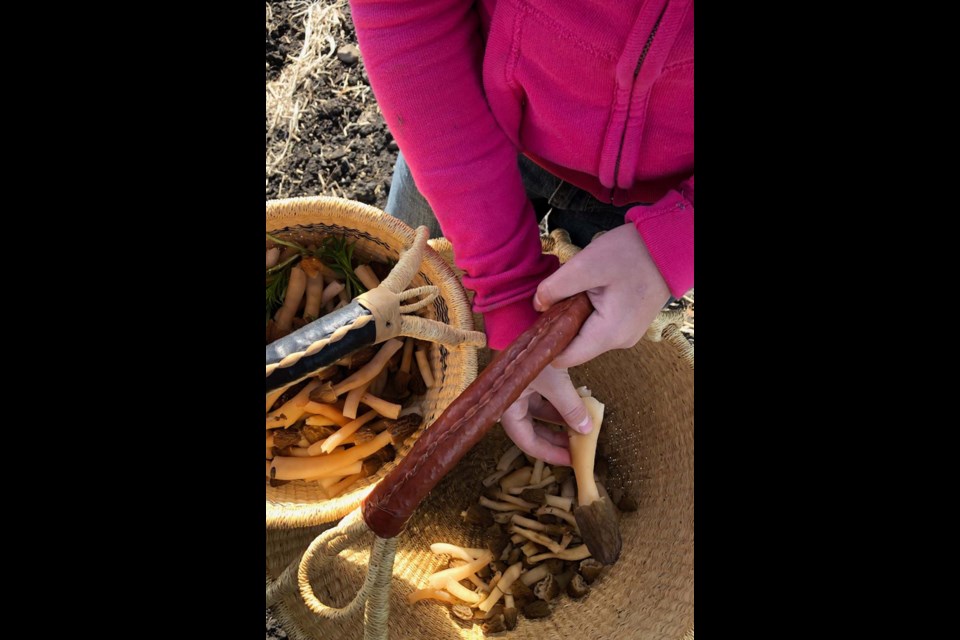It’s morel season in Alberta, if you can find them.
A dry spring and limited snow pack in central to northern Alberta has meant there hasn’t been a lot of moisture for morels to thrive, but as we head into the morel season one good rainfall could change everything.
“They come out quite quickly if we do get the rains, but this is so dependent on the moisture,” said Dr. Roland Treu, a biology professor at Athabasca University, who specializes in mycology.
Treu said the first stage of the morel season includes the spring snowmelt which brings out the early morels.
“This year was terrible in terms of snowmelt and then whether you get them or not really depends on did you have in your area some good rains,” he said.
True morels typically come out at the end of May and beginning of June in the Athabasca region, but the region is diverse, and everything is reliant on moisture.
The Edmonton region, said Treu, usually sees that date bumped up a week.
Karen Slevinsky, president of the Mycological Society of Alberta said conditions have to be right for the mycelium, the mass of fungi underground, to pop up the fruiting body, or mushroom.
“It's a combination of soil moisture, humidity, air, and soil temperature and maybe a little bit of change around it,” she said. “The change is when the trees produce sap.”
Slevinsky said some people say they find morels when the balsam leaves unfurl.
“It is true because the sap is running in those trees and the running sap is like this little disturbance in the soil. And this disturbance wakes up the mycelium and the mycelium say ‘Hey, something new is going on’…in books you will read it as a stress” she said.
There are three different types of morels in Alberta.
Early morels (verpa, mitrophora) which, according to Slevinsky and legend, show up when the saskatoons are blooming and then there are true morels (morchella) which emerge when the balsam poplar leaves unfurl; however, Treu said he watches for the nettles to come up.
Both the verpas and the morchellas are edible.
False morels (gyromitra), on the other hand, contain a toxin called gyromitrin, “which is metabolized in the human body to methylhydrazine, a chemical that is used as a rocket fuel,” according to Treu’s Mushrooms of the Athabasca Region, and are not recommended for consumption.
Treu and Slevinsky emphasized the importance of not eating unidentifiable mushrooms.
“Never ever eat anything unless you know 100 per cent what they are. If you feel you're almost sure, still don't do it,” said Treu, and added to only take fresh mushrooms and cook them well.
Slevinsky had her own piece of advice on top not eating anything unknown.
“Go out often, collect little, identify as much from the few that you collected,” she said.
True morels, morchellas, are a highly sought short-lived spring mushroom and arguably, the best tasting.
“I love morels because they just they mean that spring is here… To me (they’re) symbolic of all the other beautiful things that are about to grow,” said TobyLauren Burgess owner of Wild Haven Hills homestead, who has been foraging since she was a child.
True morels are identified by a honeycomb patterned cap and hollow stipe, according to Treu’s guidebook, and are considered to be easily identifiable, but they can be difficult for beginners to find.
Treu recommends beginner foragers join a group or an experienced mushroom picker when getting started.
“Why are they so elusive?” Slevinsky asked rhetorically. “Well, they're so well camouflaged.”
Morels, said Slevinsky, come up amongst the dead leaves and are the colour and shape of dead leaves.
“The untrained eye can walk, run, trudge right alongside them and they may not be seen,” she said.
Burgess said the first time she found morels she was with an experienced morel mushroom-picking friend
“I had never found them before. It's like your eyes aren't tuned to seeing them.
“We walked into an area by a pond. And she said, ‘Oh wow.’ And I'm looking down and I couldn't see anything,” Burgess exclaimed.
Burgess said her friend pointed down and told her to be present for a minute and just look.
“It was like something switched on in my brain and suddenly you could see this carpet of mushrooms. And they were small, but I was surrounded by them,” she said.
Burgess lives in the country “in the middle of nothing” between Vermilion and Bonnyville near a town called Derwent.
The area is right on the border between boreal forest and aspen parklands.
“We’re really in a lovely spot. It's a lakeland region, because there's so many alkali lakes but then those moist kind of boggy areas and wetlands that lend themselves to a lot of different species of mushrooms growing year-round,” she said.
Morels are found throughout Alberta, they like nutrient-rich areas, along rivers and on former burn sites.
Wildfire burn releases a huge amount of nitrogen and morels love nitrogen.
“One of the best places to look for morels are the wildfire places; however, not in the same year, the year after,” said Treu. “If you go to any of these wildfire places next year…that's where you would get (the morels).”
Despite concerns about the lack of moisture this spring, Treu said morels are adapted to drought conditions and will come back when conditions are right.
Burgess said foraging has allowed her to slow down and see what she is stepping on.
“We have to slow ourselves down and just be there with nature until it can say, ‘Here I am.’
“I swear sometimes those mushrooms will like just pop up and wave at you.”




